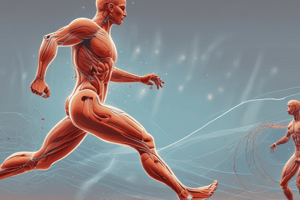Podcast
Questions and Answers
What is the primary energy system utilized for short bursts of exercise like sprints?
What is the primary energy system utilized for short bursts of exercise like sprints?
- Beta oxidation
- Aerobic metabolism through Krebs cycle
- Anaerobic glycolysis
- ATP-CP system (correct)
Which energy system can provide energy for up to 2 minutes of high-intensity exercise?
Which energy system can provide energy for up to 2 minutes of high-intensity exercise?
- Aerobic metabolism through Krebs cycle
- Anaerobic glycolysis (correct)
- Beta oxidation
- ATP-CP system
What is the rate of ATP-CP energy transfer compared to glycolysis or aerobic metabolism?
What is the rate of ATP-CP energy transfer compared to glycolysis or aerobic metabolism?
- 10-12 times faster
- 2-3 times faster
- 4-8 times faster (correct)
- Equal
What can training potentially increase to enhance aerobic metabolism and delay lactate accumulation?
What can training potentially increase to enhance aerobic metabolism and delay lactate accumulation?
In which type of exercise does aerobic metabolism through Krebs cycle and beta oxidation primarily utilize oxygen?
In which type of exercise does aerobic metabolism through Krebs cycle and beta oxidation primarily utilize oxygen?
Which energy systems predominate in short bursts of exercise?
Which energy systems predominate in short bursts of exercise?
How does training enhance aerobic metabolism?
How does training enhance aerobic metabolism?
Which muscle fiber type relies more on glycolysis?
Which muscle fiber type relies more on glycolysis?
What is the measure of maximal oxygen consumption?
What is the measure of maximal oxygen consumption?
What does reporting relative VO2 account for?
What does reporting relative VO2 account for?
What techniques can be used for measuring maximal oxygen consumption?
What techniques can be used for measuring maximal oxygen consumption?
What do trained athletes do to delay lactate accumulation?
What do trained athletes do to delay lactate accumulation?
What is the primary energy system after ATP-CP is depleted?
What is the primary energy system after ATP-CP is depleted?
What is the importance of VO2 max testing?
What is the importance of VO2 max testing?
Flashcards are hidden until you start studying
Study Notes
Exercise Physiology Lecture Summary
- Anaerobic glycolysis generates ATP by breaking down glucose after ATP-CP is depleted
- Aerobic metabolism through Krebs cycle and beta oxidation utilizes oxygen for lower intensity, longer duration exercise
- All energy systems operate simultaneously, with ATP-CP and glycolysis predominating in short bursts, and aerobic metabolism taking over during longer exercise
- Training enhances aerobic metabolism by increasing mitochondria density, capillary density, and aerobic enzymes to delay lactate accumulation
- Key topics in the lecture included energy systems, lactate threshold, muscle fiber types, oxygen consumption, and VO2 max testing
- Trained athletes delay lactate accumulation by increasing mitochondrial density and capillary density
- Differences between fast and slow twitch muscle fibers were discussed, with fast twitch fibers relying more on glycolysis and slow twitch fibers being more aerobic
- Maximal oxygen consumption (VO2 max) and the differences between plateau in VO2 versus peak VO2 were covered in depth
- The importance of reporting VO2 in absolute and relative terms was emphasized, with relative VO2 accounting for body size
- Risks of VO2 max testing were highlighted
- Homework consisting of short answer and long answer questions was to be assigned, likely between 12-1pm or 4-5pm, due Sunday night
- Techniques for measuring maximal oxygen consumption include open circuit spirometry and maximal graded exercise test, with submaximal exercise tests as alternative estimation methods
Studying That Suits You
Use AI to generate personalized quizzes and flashcards to suit your learning preferences.





